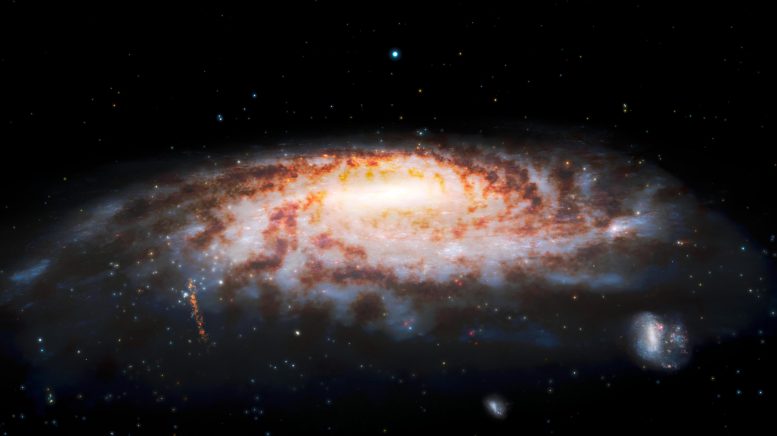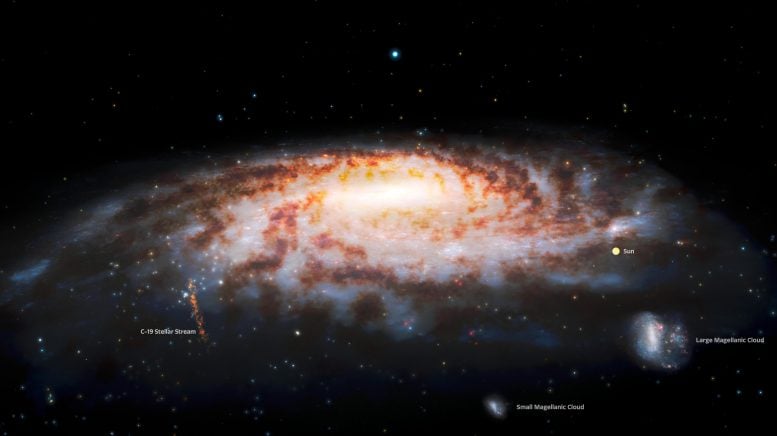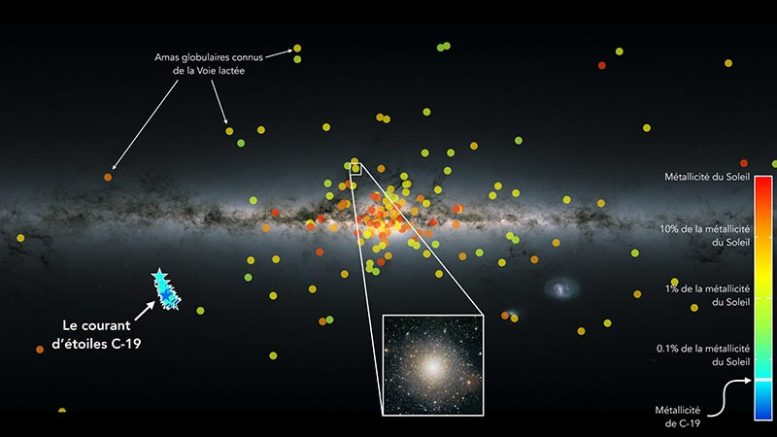
This illustration shows the location of the C-19 stellar stream (orange, vertical stream of stars in lower left), which was recently discovered at the edge of our Milky Way Galaxy. Observations using the Gemini North telescope — part of the international Gemini Observatory, a Program of NSF’s NOIRLab — reveal that the stars in this stream were once part of an ancient globular star cluster that was torn apart by gravitational interactions with our galaxy. The Large Magellanic Cloud and Small Magellanic Cloud (satellite galaxies of the Milky Way) appear in the lower right. Credit: International Gemini Observatory/NOIRLab/NSF/AURA/J. da Silva/Spaceengine, Acknowledgment: M. Zamani (NSF’s NOIRLab)
Gemini Observatory helps reveal that a stream of old stars at Milky Way’s edge is a shredded star cluster.
A primordial stellar stream discovered in the outer reaches of the Milky Way has a lower proportion of heavy elements than any known stellar system in our galaxy. Observations with the Gemini Observatory, a Program of NSF’s NOIRLab, showed that the stars in this stream were torn from an ancient star cluster and are relics from the early days of the Milky Way, which could provide insights into the formation of the first stars.
An international team of researchers including members from Europe, Canada, and Russia has discovered a unique stream of stars orbiting the Milky Way.[1] Called C-19, the stellar stream is south of the spiral of the Milky Way, and its orbit extends about 20,000 light-years from the Galactic Center at its closest approach and roughly 90,000 light-years at its farthest. The stellar stream stretches across an impressive expanse of the night sky — roughly 30 times the width of the full Moon — although it isn’t visible to the naked eye.
Using the Gemini North telescope — located in Hawai‘i as part of the international Gemini Observatory, a Program of NSF’s NOIRLab — and the GRACES instrument[2] the team realized that C-19 is a remnant of a globular cluster. In addition, the stars in the stream possess a uniquely low proportion of heavy elements, or as astronomers phrase it, low “metallicity.”[3] Globular clusters were previously thought to have metallicities no lower than 0.2%, but C-19 has an unprecedentedly low metallicity of less than 0.05% — lower than has ever been observed for a stellar system in the Milky Way or its surroundings.
The discovery that a low-metallicity stream originated from a globular cluster has implications for the formation of stars, star clusters, and galaxies in the early Universe. The very existence of the stream proves that globular clusters and the first building blocks of the Milky Way must have been able to form in low-metal environments, before successive generations of stars supplied the Universe with heavier elements.[4]

This illustration shows the location of the C-19 stellar stream, which was recently discovered at the edge of our Milky Way Galaxy. The location of the Sun is provided for reference. (The size of the Sun is exaggerated and is not to scale.) The Large Magellanic Cloud and Small Magellanic Cloud (satellite galaxies of the Milky Way) appear in the lower right. Credit: International Gemini Observatory/NOIRLab/NSF/AURA/J. da Silva/Spaceengine, Acknowledgment: M. Zamani (NSF’s NOIRLab)
“It was not known if globular clusters with so few heavy elements exist — some theories even hypothesized they couldn’t form at all,” commented Nicolas Martin of the Strasbourg Astronomical Observatory, who is the lead author of the Nature paper reporting this discovery. “Other theories suggest that they would all have long-since disappeared, which makes this a key discovery for our understanding of how stars form in the early Universe.”
Members of the team originally spotted C-19 in data from the Gaia mission[5] using an algorithm they designed specifically to detect stellar streams. The stars in C-19 were also identified by the Pristine survey — a search for the lowest-metallicity stars in and around the Milky Way using the Canada-France-Hawaii Telescope in Hawai‘i — as being interesting enough to merit follow-up observations. To identify the origin of C-19’s constituent stars, astronomers needed the detailed spectra from GRACES.[6] The team also gathered data using a spectrograph mounted on the Gran Telescopio Canarias on La Palma in the Canary Islands.

Credit: Distribution of very dense groups of stars in the Milky Way, called globular clusters, superimposed on a map of the Milky Way compiled from data obtained with the Gaia Space Observatory. Each dot represents a cluster of a few thousand to several million stars, as in the insert image of the Messier 10 cluster. The colour of the dots shows their metallicity, in other words, their abundance of heavy elements relative to the Sun. The C-19 stars are indicated by the light blue symbols. Credit: © N. Martin / Strasbourg Astronomical Observatory / CNRS; Canada-France-Hawaii Telescope / Coelum; ESA / Gaia / DPAC
“GRACES provided the critical clues that C-19 is a disrupted globular cluster and not the more common disrupted dwarf galaxy,” explained Kim Venn of the University of Victoria, the lead investigator for the GRACES observations.[7] “We already knew that this was a very metal-poor stream, but identifying it as a globular cluster required the precision metallicities and detailed chemical abundances only available with high-resolution spectra.”
The Gemini observations suggest that the cluster must have formed from very early generations of stars, making C-19 a remarkable relic from the time when the very first groups of stars were being formed. Consequently, this discovery improves our understanding of the formation of stars and star clusters that arose shortly after the Big Bang and provides a close-to-home natural laboratory in which to study the oldest structures in galaxies.
This animation shows how a globular star cluster, orbiting a still-forming Milky Way Galaxy, can get torn apart by the gravity of the developing galaxy to become the C-19 stellar stream that now orbits the present-day Milky Way. Credit: Gabriel Pérez Díaz, SMM (IAC)
“This artifact from ancient times opens a direct and unique window onto the early epochs of star formation in the Universe,” concluded co-investigator Julio Navarro of the University of Victoria. “While astronomers can look at the most distant galaxies to study the early Universe, we now know that it is possible to study the oldest structures in our own galaxy as fossils from those ancient times.”
“This international collaboration reveals startling new insight into the structure, evolution, and formation of our galaxy,” added Martin Still, Gemini Program Director at the National Science Foundation. “The Gemini observatories continue to demonstrate key advances in the understanding of our night sky, concerning the cosmic ecosystem and our own place in the Universe.”
Notes
- Stellar streams are collections of stars that once peacefully resided in globular clusters or dwarf galaxies but have since been torn apart by gravitational interactions and distorted into long rivulets of stars stretching along the original orbit of the cluster.
- Gemini Remote Access to CFHT ESPaDOnS Spectrograph (GRACES) is the result of a cooperation between the Canada-France-Hawaii Telescope (CFHT), Gemini, and NRC-Herzberg (Canada). It combines the large collecting area of the Gemini North telescope with the high resolving power and high efficiency of the ESPaDOnS spectrograph at the CFHT to deliver high-resolution spectroscopy across optical wavelengths. This is achieved through a 270-meter-long fiber optics feed from the Gemini North telescope to ESPaDOnS.
- Astronomers use the term “metals” to refer to elements heavier than helium. As most of the conventional matter in the Universe consists of the two lightest elements, hydrogen and helium, “metals” is a convenient shorthand used to describe all other elements. For example, our Sun has a metallicity of 0.012, meaning that only 1.2% of the Sun consists of elements heavier than helium (mainly oxygen, carbon, and iron).
- Elements heavier than helium are formed principally through stellar nucleosynthesis — the creation of chemical elements through fusion in the cores of stars. At the end of stars’ lives, the heavy elements they created are thrown out into the Universe and incorporated into new stars. As a result, older stars from the early Universe tend to have lower metallicities than younger stars, which formed recently in relatively metal-rich environments.
- The European Space Agency’s Gaia spacecraft was launched in 2013 with the mission of creating a precise three-dimensional map of more than a billion stars, including mapping these stars’ locations, motions, compositions, and temperatures.
- The Gemini observations were part of a Large and Long observing program led by Kim Venn of the University of Victoria (Canada). These programs are awarded to a handful of astronomers each year in anticipation of significant scientific impact and improved collaboration in the astronomical community.
- The Gemini observations revealed that sodium-magnesium ratios in C-19 stars varied by a factor of three, which is typical of stars in ancient globular clusters (mostly likely due to high-temperature hydrogen burning) and not seen in regular dwarf galaxies.
Reference: “A stellar stream remnant of a globular cluster below the metallicity floor” by Nicolas F. Martin, Kim A. Venn, David S. Aguado, Else Starkenburg, Jonay I. González Hernández, Rodrigo A. Ibata, Piercarlo Bonifacio, Elisabetta Caffau, Federico Sestito, Anke Arentsen, Carlos Allende Prieto, Raymond G. Carlberg, Sébastien Fabbro, Morgan Fouesneau, Vanessa Hill, Pascale Jablonka, Georges Kordopatis, Carmela Lardo, Khyati Malhan, Lyudmila I. Mashonkina, Alan W. McConnachie, Julio F. Navarro, Rubén Sánchez-Janssen, Guillaume F. Thomas, Zhen Yuan and Alessio Mucciarelli, 5 January 2022, Nature.
DOI: 10.1038/s41586-021-04162-2
The team is composed of Nicolas F. Martin (Strasbourg Astronomical Observatory), Kim A. Venn (University of Victoria), David S. Aguado (University of Cambridge, Instituto de Astrofíisica de Canarias, and Universitá degli Studi di Firenze), Else Starkenburg (University of Groningen), Jonay I. González Hernández (Instituto de Astrofísica de Canarias and Universidad de La Laguna), Rodrigo A. Ibata (Université de Strasbourg), Piercarlo Bonifacio (Observatoire de Paris), Elisabetta Caffau (Observatoire de Paris), Federico Sestito (University of Victoria), Anke Arentsen (Université de Strasbourg), Carlos Allende Prieto (Instituto de Astrofísica de Canarias and Universidad de La Laguna), Raymond G. Carlberg (University of Toronto), Sebastien Fabbro (University of Victoria and NRC Herzberg Astronomy & Astrophysics), Morgan Fouesneau (Max-Planck-Institut für Astronomie), Vanessa Hill (Université Côte d’Azur), Pascale Jablonka (École Polytechnique Fédérale de Lausanne and Observatoire de Paris), Georges Kordopatis (Université Côte d’Azur), Carmela Lardo (Università degli Studi di Bologna), Khyati Malhan (Stockholm University), Lyudmila I. Mashonkina (Russian Academy of Sciences), Alan W. McConnachie (NRC Herzberg Astronomy & Astrophysics), Julio F. Navarro (University of Victoria), Rubén Sánchez Janssen (UK Astronomy Technology Centre), Guillaume F. Thomas (Instituto de Astrofíisica de Canarias and Universidad de La Laguna), Zhen Yuan (Université de Strasbourg), and Alessio Mucciarelli (Università degli Studi di Bologna and INAF–Osservatorio di Astrofisica e Scienza dello Spazio di Bologna).
Article From & Read More ( Ruins of Ancient Star Cluster Discovered at the Fringes of Our Galaxy - SciTechDaily )https://ift.tt/3G8h6EY
Science
No comments:
Post a Comment